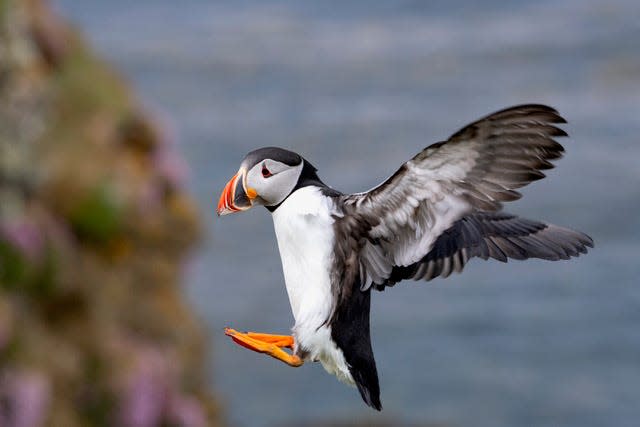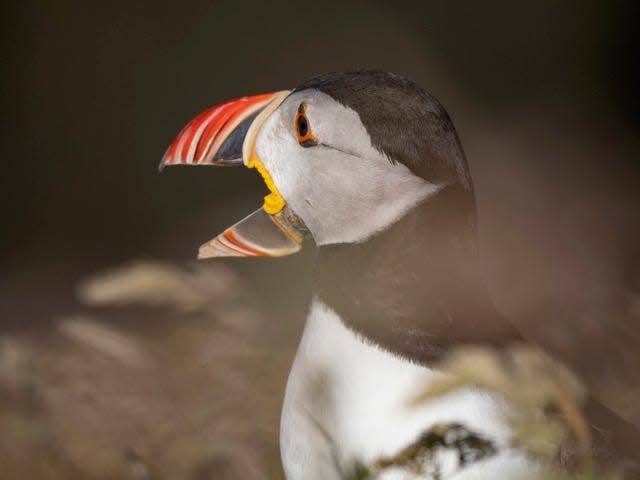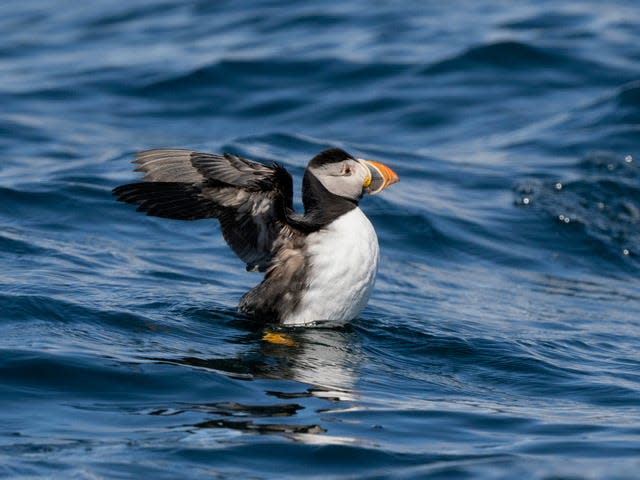Now's the time to find Atlantic puffins in nearby Maine waters: Nature News
There is one animal present in our greater backyard that I urge everyone to try to see at least once in the wild − the Atlantic puffin.
It is charismatic, beloved by everyone and an indicator of the health of its habitat (our habitat) − the Gulf of Maine. Atlantic puffins range the entire North Atlantic Ocean with approximately 60 percent of the world's puffins breeding in and around Iceland. On this side of the pond, Maine ocean islands provide the only nesting sites for Atlantic puffins in the United States, islands like Eastern Egg Rock, Seal Island and Matinicus Rock. To me these place names, and the puffins that live there, mean summer in Maine.

Atlantic puffins are a type of alcid, a group of marine birds characterized by black and white plumage and stout, streamlined bodies. They have short wings, waterproof plumage, and feet set well back on the body that fill the same ecological niche as the unrelated flightless penguins of the southern hemisphere. Representatives of this group in the Gulf of Maine include murres, guillemots and dovekies. The only species of flightless alcid that we know of was the great auk, a huge bird that was hunted to the point of extinction more than 300 years ago.
When I saw my first puffin, what first struck me wasn’t its cute black and white plumage nor its brightly colored bill, rather I was surprised by its size. My childhood impression had been something larger than life. It turns out that puffins are relatively tiny-standing perhaps 12 inches high. However, that colorful bill is its most distinctive feature. Puffin beaks (and feet) turn bright orange every spring in preparation for the breeding season. The older the puffin the larger and more brightly colored the beak - serving as an indicator of health and experience. As the season progresses, old parts of the beak wear down and new layers are revealed - those stripes you can see on a puffin’s beak are the result of this process. After the breeding season the beak colors dull, perhaps because they are no longer useful for breeding.

Puffin beaks are also a marvel of engineering. If you take a close look you will notice a bright orange rosette of flesh at the base (the hinge). This allows a puffin to open its beak much wider than a typical beak. Instead of opening like a pair of scissors, their beaks open more like an adjustable wrench. This gives them more space and flexibility in the opening allowing them to hold a huge number of fish (the record is 62 small fish). They also have a raspy tongue that holds caught fish against serrations on their boney palate while they swim around catching even more fish. Imagine how hard that must be - holding the fish in your mouth while, at the same time, swimming about and catching more! Besides being awesome hunters and swimmers, they can fly really fast, up to 55 mph! They achieve these speeds by beating their wings up to 400 times per minute − so fast that the wings appear blurred!
Puffins have had a beleaguered history in the Gulf of Maine since early colonization. They almost disappeared from the Gulf of Maine due to overhunting. Settlers used them both for food (both the meat and eggs) and feathers. According to Project Puffin, they were eliminated from all but one of their nesting islands in Maine by the late 1800s. But, in the 1970’s, nearly 100 years later a young scientist named Stephen Kress began an effort known as Project Puffin to restore puffins to Easter Egg Rock. Since then the population has begun to recover, with puffins nesting on a number of islands off the coast. Success for these little seabirds is tied to healthy marine environments and these days puffins are alerting us to a new threat. Warming waters in the Gulf of Maine are driving away the small cold-water loving fish, like herring and hake, upon which they (and a variety of other seabirds) depend. Starvation is a real threat.

The good news is that we are recognizing the broad impacts of human-caused climate change and are beginning to take steps to slow the pace of global warming, hopefully in time to save vulnerable species such as the Atlantic puffin.
June and July are the best months to see Gulf of Maine puffins on and around the islands. In the early morning you can find them flying to and from their nests (they nest in burrows) as they fish and bring back food for their young (adorably known as pufflings). In the evening you might see large rafts of puffins relaxing on the surface or hanging out on the rocks. You can also learn more by visiting The Project Puffin Visitor Center in Rockland, Maine or checking out the newest findings on a variety of seabird restoration projects online at Audubon’s Seabird Restoration Institute (seabirdinstitute.audubon.org).

Susan Pike, a researcher and an environmental sciences and biology teacher at Dover High School, welcomes your ideas for future column topics. Send your photos and observations to spike3116@gmail.com. Read more of her Nature News columns online at Seacoastonline.com and pikes-hikes.com, and follow her on Instagram @pikeshikes.
This article originally appeared on Portsmouth Herald: Now's the time to find puffins in nearby Maine waters: Nature News

